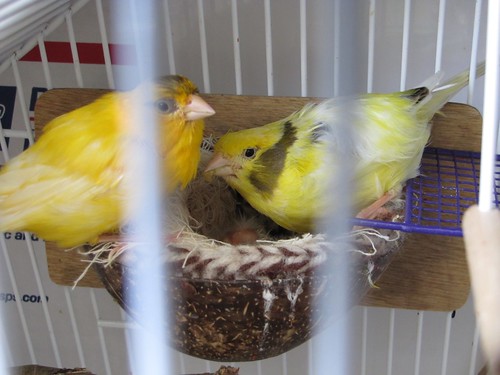Health
Canary Birds can be great companions but they are delicate creatures that need
to be taken special care of.
A good diet will keep health problems at bay. Provide fresh food
and water every day. Fresh canary seed is their staple diet. Vegetables like
peas, celery, spinach, watercress are good supplements for them. Apples,
oranges, melons, bananas, and grapes are good too. Mix honey with the seeds for
an occasional treat. Bits of hard boiled egg can be given sometimes as
well.
Canaries are generally very clean birds and would be quite
happy to bathe themselves daily. Be sure to provide your canary with a
bath regularly. If you can, let him bathe every day or even every three
or four days. Bathing is very important for canaries when they are
molting and breeding. You will need to occasionally trim the canary’s
nails but ensure that you never clip into the veins. The canary can
quickly bleed to death if this happens. As far as bird cages for
canaries are concerned, choose one that is large and roomy.
Excessive
moulting can indicate stress – seek advice from your vet. As with all birds, if
you are worried about any aspect of your Canary’s health, seek advice from an
Avian veterinarian. For a healthy life, your Canary needs the following:
- A good balanced diet with no
sudden changes
- Plenty of toys to keep them
amused
- Water bottle and feed bowls
cleaned daily
- Use peaches that file nails
avoiding clipping by a vet or experienced person which is stressful for
your bird
- A daily bath – essential for
their preening activities
- Regular exercise outside
their cage
A healthy
Canary should:
- Be active and brisk, and
move freely around the cage or aviary.
- Be clean, bright and colorful
in appearance.
- The eyes should be clear and
bright.
- May not be singing but
should be chirping and making noise.
A healthy
Canary should NOT:
- Be puffed up and sitting
motionless.
- Have watery or sore eyes;
eyes may also be red and inflamed.
- Should not sneeze or shiver.
Have watery discharge from the beak.
- Should not have droppings
that are white and watery.
- Be “light” with little or no
body weight. Have droppings/faeces around vent.
The best
way to prevent various canary diseases is to provide a healthy diet and proper
living conditions. However, your bird may still get sick at some point in
his lifetime. There are a variety of illnesses that can affect your
bird. This article will discuss some of the most common conditions that
can cause problems.
Mites
There are a variety of mites that can affect your canary. Air sac mites
infect his lungs and throat. Other types cause problems with the legs,
face, or feet. Some mites burrow into your bird's feathers and feed on
decaying residue. Red mites suck on his blood.
Tapeworms
Tapeworms usually cause problems with birds that are kept outside. They
can infect your cat when he ingests an infected insect. The worms eat
nutrients from the bird's food, causing malnourishment. As they multiply,
they can cause a life-threatening blockage in the digestive tract.
Pox
One of the most serious canary diseases is pox. This viral infection is
transmitted via wild birds and mosquitoes. Most birds experience crusty
sores around their beak, feet, and eyes. The diseases can also cause
lesions to develop on the pharynx, larynx, and tongue. There is no cure
for this illness, and it's usually fatal in most cases.
Constipation
Constipation is a less serious illness. It's just like the condition that
affects humans. It's characterized by your bird's inability to pass
droppings. You can help relieve the condition by giving him green
vegetables. Two of the most common choices include water-cress and
lettuce.
Canary claws or nails can end up having a
negative effect on canary health if allowed to grow out of control.

Fortunately, canary nails don't grow near as quickly as humans.
They will need
to be clipped about
twice per year.
Some people recommend wrapping the perch with sandpaper to keep the canary's nails wore down. THIS IS A NO-NO! The sand paper will damage your canary's feet.
When you clip your canary's nails look carefully for the vein inside the nail.
Stay well away form this vein...
It can sometimes be difficult to stop the bleeding
if you cut into it.
--The nail clipping sketch is from "The Canary Handbook" by Mathew M. Vriends.--
Loveofpets 2012 How to clip a canary nails,
online video,
12 May, accessed
18 June 2014, <
https://www.youtube.com/watch?v=17HgSOviqIM>.
This show you how to chip the feet or your canary on the YouTube sit of loveofpets there are a number of care for pet videos.
links
Canary care sheet,
2014 , accessed
29 May 2014, <
http://birdsville.net.au/pet-bird-advice-and-training/care-sheets/canary-care/>.
This site are of low to medium authority, this sites are good for a older person who is looking for information on for canary health.
canaries: wheezing.sneezing..helped a bit but I call my vet.mites,
2014 , accessed
29 May 2014, <
http://www.justanswer.com/pet/0yd2f-two-female-canaries-wheezing-sneezing.html>.
This site are of low to medium authority, this sites are good for a older person who is looking for information on for canary health.
Canary Health Care For Your Canary Bird., 2014 , accessed 29 May 2014, <http://www.canaryadvisor.com/canary-health.html>.
This site are of low to medium authority, this sites are good for a older person who is looking for information on for canary health.
book
Brian, K 2006,
Cannary ownwer's guide a guide to selection, houseing, care, nutrion,health,breebing and colour,
3 edn,
About pets australian editon landmark press,
Drouin, victoria.
this book is mediun to hight atherd as it was made for the cannary lovey and can be used buy any teen to old ages.
most of the links were back up with this book or other sites.





